I was racking my head on what to cook for this month's IMBB since there are so many ways to present eggs that I sought divine inspiration by flicking through some cookbooks. I found this very informative book called Encyclopedia of Asian Food - The Definitive Guide to Asian Cooking by Charmaine Solomon. I love the way she explained things especially the way she categorised her egg dishes so I borrowed her indexing to give you an insight on my take on eggs in Malaysia. It may not be comprehensive and feel free to advise on any other eggy dishes that should be added.
Background
Eggs are easily available and reasonably priced in Malaysia thus making it an important source of nutrients. Usually eggs are supplied en masse by poultry farms but occasionally you will get small stall owners selling eggs fresh from the kampung (Malay for village) or their own backyard. Nowadays not that many people rear chickens in the urban city as they feel it's too dirty or troublesome to keep chickens at home. When I was a kid, I remember we had a pair of small white chickens (not sure what their breed was) and they used to lay a teeny weeny egg for my breakfast.
Nowadays there are so many kinds of eggs to choose from; organic ones, special ones with no cholestrol, Omega 3 eggs and etc. They also come in different sizes; small, medium and large. Small eggs are ideal to half boil and the yolk is larger than a normal egg. Medium eggs are generally used for baking and cooking. Large eggs have more egg white, extremely ideal to make chiffon cakes and sometimes there could be double yolks inside.
Duck eggs are used to make salted eggs and century eggs. Salted eggs are a popular condiment for porridge. In China where these eggs originated, the Chinese discovered that to preserve the egg, they can soak it in brine for more than a month. Once soaked, it is encased in salted mud and straw. By soaking the egg in brine, the egg white gets more firmer while the yolk gets denser as water in the egg is drawn out with osmosis. As there will still be bacteria within, it is advisable to cook the salted eggs either by hard boiling them or cooking them with their ingredients. Nowadays, restaurants use the raw salted egg yolk to fry crab or prawns as the sweetness of the seafood complements the salty and creamy taste of the salted egg yolk perfectly.
Century eggs or thousand year eggs are coated in salt, wood ash and lime mixed to a paste with water. It is an acquired taste for these eggs as the eggs are black in colour while the yolk turns greenish goo. Some also avoid it as they can't stand the smell and they claim that it is actually cured in a mixture of horse urine and mud. Usually, the eggs are used in porridge or just eaten plain with ginger pickles. It is also used to make the three egg steamed egg custard dish together with salted eggs and hen's eggs that Chinese homes love to serve.
Quail eggs are sought after as a delicacy by some but has dropped in popularity with Malaysians as they are deemed to be extremely high cholestrol for adults. They are usually used as part of dessert with some sweet syrup. You can also add quail eggs to curries.
Quail eggs are sought after as a delicacy by some but has dropped in popularity with Malaysians as they are deemed to be extremely high cholestrol for adults. They are usually used as part of dessert with some sweet syrup. You can also add quail eggs to curries.

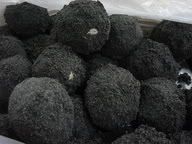
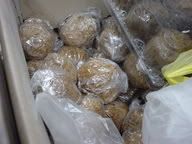

Top Left: Fresh eggs, Top Right: Salted duck eggs
Bottom Left: Century eggs, Bottom Right: Quail Eggs
Scrambled Eggs
Scrambled eggs does not really feature that big in Malaysian cuisine so it took me a while to look for a picture of one. I found one in this hawker's version of Oh Chien (Chinese for Oyster Omelette). Although it should come in a form of an omelette with the Oh (Chinese for oyster) on top, some hawkers in Malaysia have different intepretation of it. So far besides this scrambled version, I have seen some which have cooked the oysters in the omelette until it's crispy and one which made it thicker and like a frittata.
For the Chinese, plain scrambled eggs is so boring that usually they throw in other delicacies like shark fins, crabmeat and water chesnuts in their version called kwai fah chee that is served in restaurants.
Nasi Lemak, what Malaysians may call their national dish that comes with rice cooked in coconut milk served with sambal, slices of cucumber, fried peanuts, fried ikan bilis (Malay for anchovies) and egg. Usually the egg is either hard boiled or fried but there is one stall owner in Bangsar, Nasi Lemak Lee that serves up his version with scrambled eggs.

Oh Chien - all scrambled out
Omelettes
Omelette is also not featured in a big way in Malaysia and is usually added on as a topping or a garnish to an exisiting dish like fried rice or fried noodles. In this version of Lam Mee, strips of omelette are added on to the noodles as decoration and additional ingredients. Lam Mee is also known as Birthday Noodles and is served for birthday occasions especially in Penang.
For my second omelette dish, I had to turn to Thai hawkers. As Thailand is our neighbour, Thai food has kinda creeped into our system and has become a permanent feature in hawker centres and mamak stalls. This popular version is called Telur Bistik, where they cook the omelette in a sweet and sour sauce with vegetables. Ideal as a quick meal for lunch or dinner with lots of piping white rice to soak up all that tangy sauce.

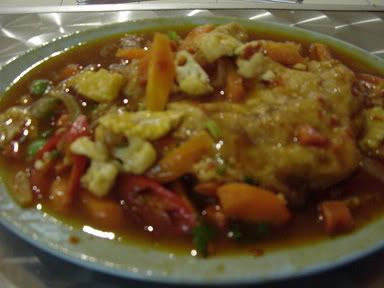
Left: Lam Mee, Right: Telur Bistik
Boiled Eggs
Hard boiled eggs is used extensively in Malaysia and you can see them everywhere as garnishes and toppings for rice and noodle dishes like Nasi Lemak, Mee Siam, Laksa and etc.
One popular way Teochews cook their eggs is with soya sauce and they call it Tau Yu Tan (Chinese for Soya Sauce Eggs). These eggs are brown in colour after being stewed in the sauce and is ideal for eating with white porridge.
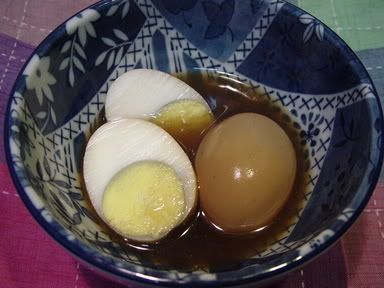
Tau Yu (Soya Sauce) Egg
For the Malays, hard boiled eggs can be used to make Sambal Telur, where hard boiled eggs are cooked and then deep fried. Then a hot and spicy sauce is prepared from lots of chillies which is added with the hard boiled eggs. The Indians also deep fry their hard boiled eggs and add it in their rojak together with other fried stuff, some sotong and shredded cucumber and carrots. Then a hot and spicy peanut sauce is poured on top. As the rojak is extremely spicy, the rojak man always sells it together with a cendol man which is a cold dessert that helps bring down the heat of the rojak.
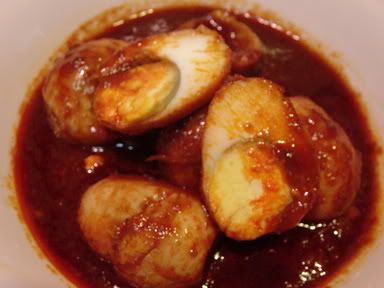
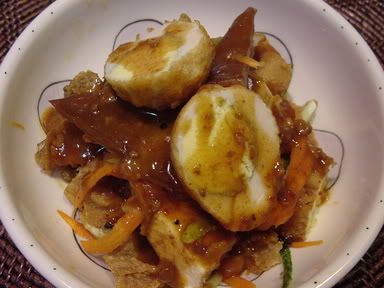
Left: Sambal Telur, Right: Indian Rojak
A popular snack is marbled tea eggs, where eggs are cooked in tea and Chinese herbs so they absorb the flavours. The eggs are lightly cracked all over and boiled in the tea to get the marble effect. In Malaysia, it is easy to make these eggs as the Chinese herbal shop can pack all the ingredients for you and all you need to do is just boil them. In Indonesia, it seems they also have their own Marbled eggs version, which they use colouring to get the marbled look.
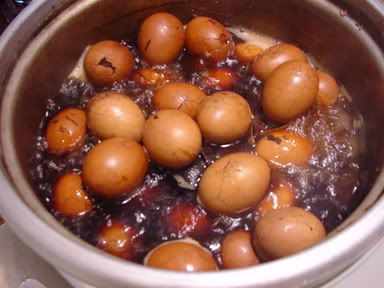
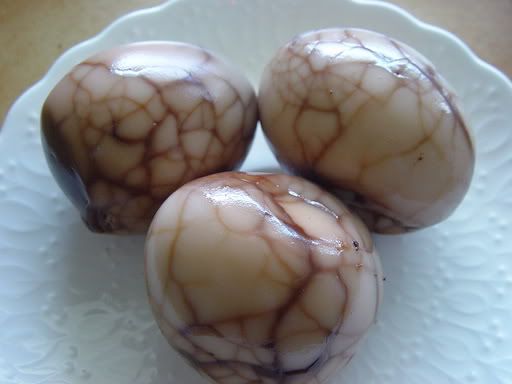
Left: Tea Eggs being prepared, Right: Tea Eggs - uncracked
Steamed Eggs
Steamed eggs feature prominently in Chinese food and is extremely popular at Chinese economy stalls that serve a selection of home cooked food at reasonable prices for lunch and dinner. As eggs are relatively cheap, these stalls will have several varieties and the popular ones are plain steamed eggs or steamed eggs mixed with minced meat. Another steamed egg dish that is popular has the three eggs; salted egg, century egg and hen's eggs. Besides these dishes, you can also add eggs to soya bean milk to make your own steamed egg tofu. Steamed egg custards can also be made as dessert where you steam them with milk and ginger. If you go a town up north called Ipoh, this is readily available in coffeeshops.
One popular way Teochews cook their eggs is with soya sauce and they call it Tau Yu Tan (Chinese for Soya Sauce Eggs). These eggs are brown in colour after being stewed in the sauce and is ideal for eating with white porridge.

Tau Yu (Soya Sauce) Egg
For the Malays, hard boiled eggs can be used to make Sambal Telur, where hard boiled eggs are cooked and then deep fried. Then a hot and spicy sauce is prepared from lots of chillies which is added with the hard boiled eggs. The Indians also deep fry their hard boiled eggs and add it in their rojak together with other fried stuff, some sotong and shredded cucumber and carrots. Then a hot and spicy peanut sauce is poured on top. As the rojak is extremely spicy, the rojak man always sells it together with a cendol man which is a cold dessert that helps bring down the heat of the rojak.


Left: Sambal Telur, Right: Indian Rojak
A popular snack is marbled tea eggs, where eggs are cooked in tea and Chinese herbs so they absorb the flavours. The eggs are lightly cracked all over and boiled in the tea to get the marble effect. In Malaysia, it is easy to make these eggs as the Chinese herbal shop can pack all the ingredients for you and all you need to do is just boil them. In Indonesia, it seems they also have their own Marbled eggs version, which they use colouring to get the marbled look.


Left: Tea Eggs being prepared, Right: Tea Eggs - uncracked
Steamed Eggs
Steamed eggs feature prominently in Chinese food and is extremely popular at Chinese economy stalls that serve a selection of home cooked food at reasonable prices for lunch and dinner. As eggs are relatively cheap, these stalls will have several varieties and the popular ones are plain steamed eggs or steamed eggs mixed with minced meat. Another steamed egg dish that is popular has the three eggs; salted egg, century egg and hen's eggs. Besides these dishes, you can also add eggs to soya bean milk to make your own steamed egg tofu. Steamed egg custards can also be made as dessert where you steam them with milk and ginger. If you go a town up north called Ipoh, this is readily available in coffeeshops.
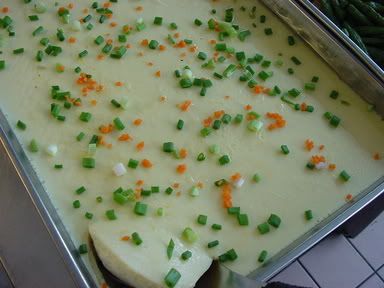

Left: Plain steamed egg, Right: Steamed egg with minced meat
Egg Combinations
As eggs are seen as a source of nourishment, they can be added to existing dishes. In most hawker stalls that serve rice or noodle dishes, it is not unusual for you to add one egg into your serving especially if you feel the portions are too small for your liking. Roti Canai which is extremely popular in Malaysia has several versions and this one has an egg added in it to create Roti Telur which is enjoyed with some curry.
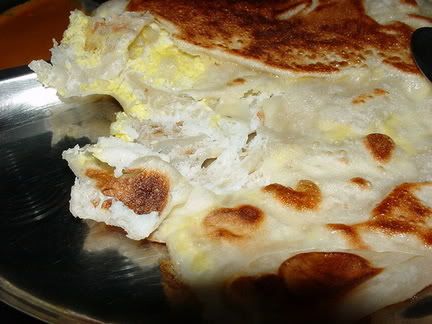
Roti Telur
Half Boiled Eggs
When I was young, my mother always insisted we take one half boiled egg before we went to school as additional nourishment. While I gobbled mine up, I still can remember my sister scrunching up her face to eat them as she hated eating eggs that way.
Nowadays half boiled eggs are back in high fashion as people flock to kopitiams (old coffee shops) to eat toasted white bread with butter and kaya, half boiled eggs and a cup of local coffee. The traditional way of making half boiled eggs at these kopitiam shops in to place the eggs in an enamel jug and pour boiling hot water to cover them. Leave them for about ten minutes and it is ready to eat. If you want to expedite the cooking process you can cover it as per the picture so it may take five to six minutes. Your eggs must be small size, extremely fresh and at room temperature.
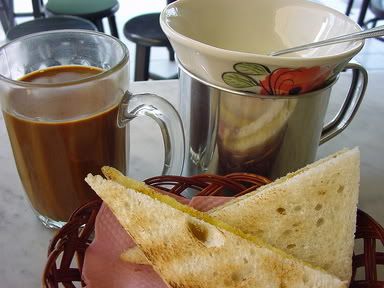
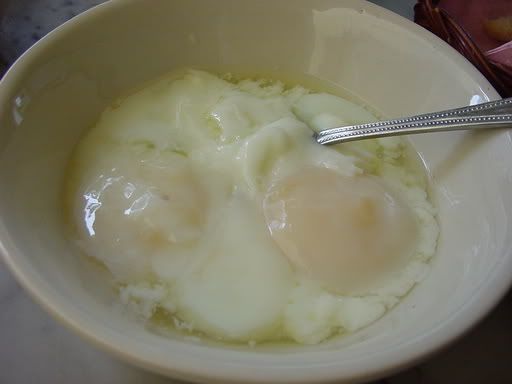
Left: The breakfast set with coffee, toast with kaya and half boiled eggs, Right: Eggs - unveiled
Eggy Desserts
Eggs are also used in desserts and one popular way to cook them is to make kaya which is coconut egg jam. The process of making kaya is quite tedious as you need to boil the eggs with coconut milk in a double boiler for quite a long time at low heat. It will thicken and caramelised into a brown jammy substance. Sometimes, pandan juice is added to flavour kaya. It is used to spread on toasted bread and in this instance paired up with a Nyonya cake called Pulut Tai-Tai, that is glutinous rice coloured blue and white.
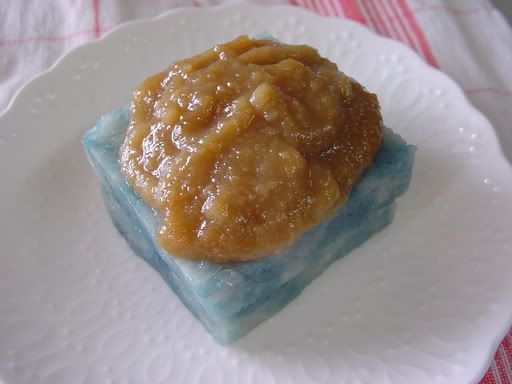
Pulut Tai Tai with lashings of kaya on top
Another amazing eggy dessert is the egg tart, where the pastry surrounding the eggy custard is flaky and melts in your mouth. This egg tart is from Tong Kee Confectionery which has been serving egg tarts for the longest time ever. When I was a kid, we always had these egg tarts for tea. Till now, that tradition still continues and the quality of their egg tart has remained unchanged.

Oh so flaky egg tarts
Eggs as Wrappers
Eggs can also be used as a wrap for your food that look beautiful and also adds nourishment to your meal. A popular dish in hawker stalls is this Nasi Pattaya (Malay for Pattaya Rice) where fried rice is placed inside an omelette that is shaped like a pouch. Break open your egg pouch to get to your piping hot fried rice. This is also another Thai influenced dish that is now a permanent fixture in our roadside hawkers as a quick and easy meal.

Nasi Pattaya with chili sauce
Eggs as tradition
Besides using them as delicious dishes, eggs are also used as traditions in Malaysian culture. The Malays like to distribute the bunga telur (Malay for flower egg) during weddings to their guest together with a hard boiled egg. The egg is said to symbolise fertility and the hope that the marriage will produce many children.
For the Chinese, they will distribute red eggs on the baby's full moon or first month anniversary that symbolise new life and good luck. Red eggs are also made for birthdays as a symbol of prosperity and happiness for the birthday boy/girl.
Besides using them as delicious dishes, eggs are also used as traditions in Malaysian culture. The Malays like to distribute the bunga telur (Malay for flower egg) during weddings to their guest together with a hard boiled egg. The egg is said to symbolise fertility and the hope that the marriage will produce many children.
For the Chinese, they will distribute red eggs on the baby's full moon or first month anniversary that symbolise new life and good luck. Red eggs are also made for birthdays as a symbol of prosperity and happiness for the birthday boy/girl.
1 comment:
bravo! what a complete series of eggs ya! i love thong kee egg tart the most! i always drive to their factory / outlet at jln pudu to source for the fresh and hot one! yummy!!!!!!
Post a Comment